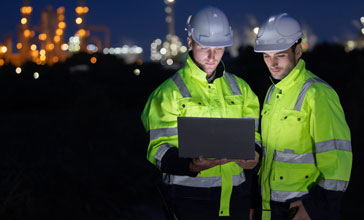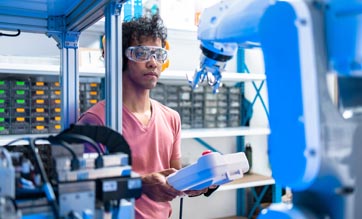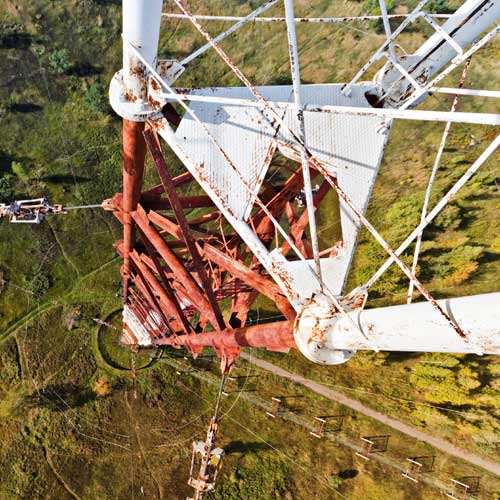Remote visual inspection from Zurich engineering
Zurich Engineering can provide remote visual inspection (RVI) of equipment, to minimise the risk of death or serious injury which can occur when working in confined spaces or at height.
The use of RVI can help organisations to comply with the Work at Height Regulations 2005 and the Confined Spaces Regulations 1997, which state that working at height or in confined spaces should be avoided where possible.
RVI can also be used where access for conventional examination is limited, for example, gas loaded hydraulic accumulators where non-destructive testing and RVI can be combined to provide an alternative to the disruption of proof testing.
What does a remote visual inspection involve?
RVI equipment usually involves a hand-held manipulator with a camera and light source which feeds back images to the operator.
Zurich Engineering’s service involves the following steps.
Firstly, we assess the practicality of carrying out an RVI, usually using drawings or photographs of the equipment.
We then carry out an initial assessment of each item of equipment from which a suitable inspection plan can be devised, minimising the risks from entering confined spaces or working at height.
We then carry out the RVI in accordance with the inspection plan, using boroscopes, fibrescopes and other bespoke equipment. Finally, we produce a comprehensive inspection report for each item of equipment, featuring picture and video evidence, along with any recommendations for remedial actions.

Talk to us about remote visual inspection
Our office hours are 9am - 5pm, Monday - Friday
(We may record or monitor our calls to improve our service)

Our accreditations
Useful inspection information
The term - 'Competent Person'
The Management of Health and Safety at Work Regulations 1999, (MHSWR) Regulation 7 (1) states that every employer shall, subject to paragraphs (6) and (7), appoint one or more competent persons to assist him in undertaking the measures he needs to take to comply with the requirements and prohibitions imposed upon him by or under the relevant statutory provisions and by Part II of the Fire Precautions (Workplace) Regulations The Provision and Use of Work Equipment Regulations 1998, (PUWER) Approved Code of practice (ACoP) states that ‘The competent person should have the necessary knowledge and experience'.
Zurich Engineering as a 'Competent Person/Body'
In order to comply with the approved codes of practice for the regulations under which plant and equipment is subject to periodic in-service inspections or thorough examinations, a Competent Person is likely to be a corporate body rather than an individual because of the necessary requirement to have access to a wide variety of technical expertise and specialist services such as non-destructive testing (NDT). One indication of competence is accreditation and certification. For inspection bodies, there are several indicators of competence and Zurich Engineering hold the following:
- UKAS accreditation - ISO17020 Type A inspection body.
- UKAS accreditation - ISO17065.
- Quality Management System Certification - BS EN ISO 9001.
- Trade Association (SAFed) membership.
- Compliance to SAFed Standard SS01 (assessed as part of Inspection Body accreditation).
Reporting status and defect code guide
Serious defects (AE)
This status indicates that a defect that poses (or could pose) a risk of injury to persons has been identified and that it must be reported to the enforcing authority. For most items, a defect that is required to be reported to the enforcing authority also poses an immediate or imminent danger to persons and the report will indicate this. For power presses, defects that need to be reported to the enforcing authority include those that do not pose immediate or imminent danger to persons. If the defect is not ‘immediate’, the report will indicate the date by which any rectification work should be undertaken.
Serious defects (AN)
This status indicates that a defect that poses (or could pose) a risk of injury to persons has been identified but that it does not require reporting to the enforcing authority. If there is immediate or imminent danger to persons, then the report will indicate this. If there is no immediate danger to persons, the report will indicate the latest date by which any rectification should be undertaken.
'B' defect (BD) or Other defect (in the case of power presses)
This status indicates that a defect has been identified but that, in the engineer surveyor's judgement, it does not pose a specific risk of injury to persons as defined in the respective regulations to which the item has been inspected. The defect should be assessed by the customer, as soon as reasonably practicable, and appropriate action taken if deemed necessary by the customer.
Deleted item (DL)
Indicates item has been removed from the schedule.
Not located (NL)
Indicates that an Engineer Surveyor has not been able inspect or thoroughly examine the item because the customer has not presented it for inspection or thorough examination and the engineer surveyor has been unable to locate or identify it.
Not available (NV)
Indicates that an item has been identified and located but we have not been able to complete an inspection or thorough examination because the item was not able to be inspected or thoroughly examined, e.g., out of service awaiting repair or not adequately prepared
OK
Indicates that an inspection took place and no defects were detected. However, the customer should view the reports for observations as these may provide useful information.
Customer advice (CA)
Indicates a Customer Advice, issued for important advice / informational purposes only.
Postponement (PD)
Indicates a Pressure item examination has been postponed in accordance with regulation 9(7) of the Pressure Systems Safety Regulations 2000 (PSSR)
General notes
We recommend that all reports of inspection and thorough examination are reviewed to ensure you are aware of the content.
Any item that has not been inspected by the due date on the current report of inspection or thorough examination should be taken out of service until the statutory inspection has taken place unless it has been postponed in accordance with regulation 9(7) of PSSR. Where defects have been identified and reported as requiring remedial action within a specified time, these should be rectified within the specified time period.
For all defects we recommend that the customer should review any relevant risk assessments and working procedures to ensure the continued safety of employees and other people that might be affected.
Managing statutory equipment can be difficult and needs tight control to avoid potential issues when equipment is used beyond its due inspection or thorough examination date. One way to control the use of equipment is to physically tag or “colour code” when it has been inspected or thoroughly examined and is safe to use.
Various types of colour coding can be used in different ways to distinguish when a piece of equipment is still safe to use and these options can be discussed with our teams
Whilst colour coding can be a cost-effective method of indicating the suitability of the equipment for further use, there are other options available for the control of equipment. Date stickers, date tags and rubberised tags are all potential options depending on the environment in which equipment is used, and Zurich Engineering are able to offer a number of options depending on your needs, so please speak to our teams to discuss.
More information

Engineering inspection
Find out about our other engineering inspection services, from lifting equipment to pressure systems

Engineering insurance
Zurich Insurance Company Ltd offer a wide range of engineering insurance covers for owned and hired-in plant and machinery

Engineering technical services
Find out more about our Technical Services offerings

